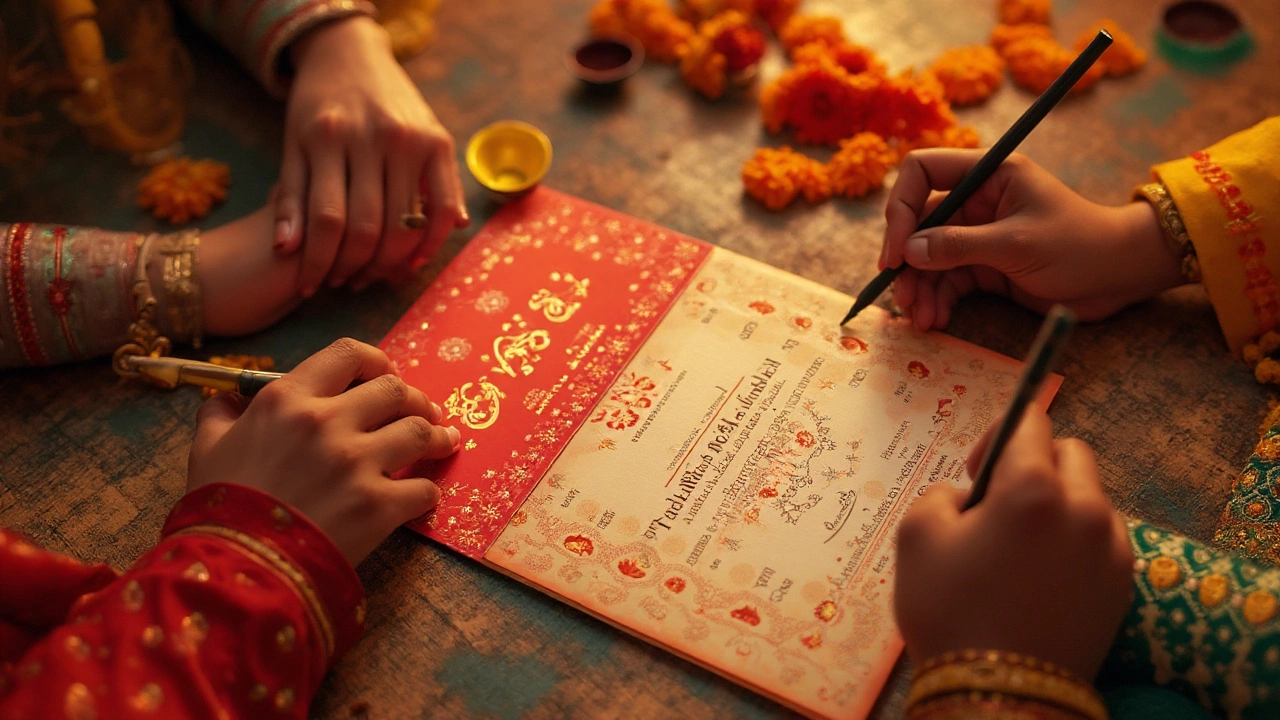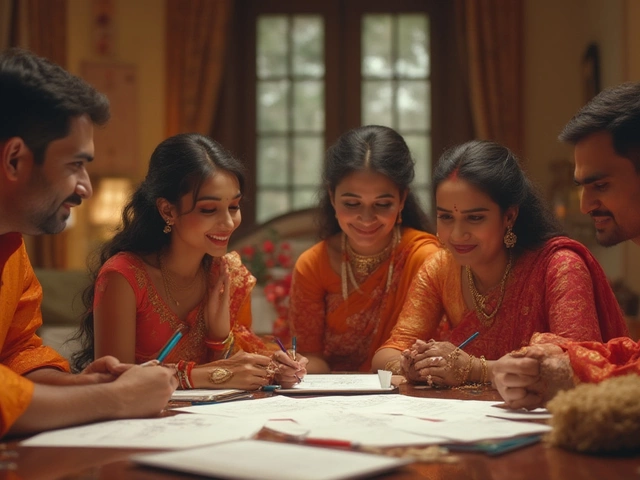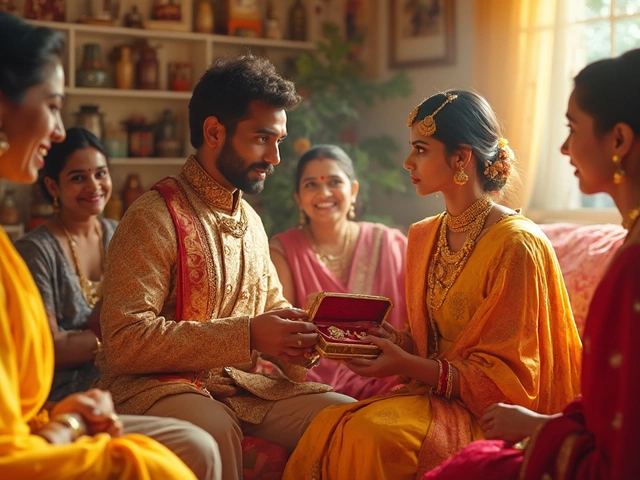
Picture this: You're finally looking at your dream wedding invitations, glossy cardstock in hand, and suddenly you freeze. Should your name go first or your partner's? Or maybe it’s your parents’ names at the top? Weirdly, this small detail causes more debates than ‘which side of the bed is mine’. But it’s not just about ego—there’s history, etiquette, and family traditions bundled up in those few little lines.
The Traditional Rules of Name-Ordering
British traditions have been running the show on most wedding invitation etiquette, even influencing modern guides across the pond. According to the oldest rulebook—think Debrett’s or the classic Wedding Etiquette by Emily Post—names are listed in a specific order based on who is “hosting.” The host, typically the party (person or people) footing the bill, comes first. In practice, that meant the bride’s parents were usually hosting, so invitations would say: "Mr. and Mrs. John Smith request the pleasure of your company at the marriage of their daughter, Emily Rose, to Mr. Thomas Brown…" and so on. Sounds stiff, but that’s what you’d find for most of the 20th century.
Modern weddings aren’t as strict, but those traditions still have a grip. Etiquette guides published as recently as 2023 by Minted and Brides.com still recommend this host-first format. Only about 43% of UK couples in 2024 stuck to the classic wording if their parents paid for the event (according to a survey by Hitched.co.uk). If the couple themselves are hosting (paying), then the invitation flips to: "Emily Rose Smith and Thomas Brown request..." with the bride’s name still first—but now it’s more of a default than a rule.
There’s also the subtle detail that, in heterosexual couples, the woman’s name is traditionally listed first “out of courtesy.” This dates back to Victorian social etiquette and chivalry, but honestly, most guests reading your invite won’t have a clue about the origins. Some see it as romantic; others, a relic. But if you care about box-ticking, that’s the source.
Modern Couples: Mixing Things Up
Times change, and so does etiquette. While some couples still cling to tradition, others are rewriting the rulebook. The clearest change? Who pays. According to Bridebook’s 2025 UK Wedding Survey, 68% of couples now fund their own wedding—so ‘the couple’s names first’ looks a lot more natural. This is the standard wording for modern, couple-hosted invitations: "Emma Wilson and Sophie Bailey invite you to celebrate..." Who goes first here? Genuinely, it’s up to you. Most opt for alphabetical order or whatever “sounds right.” Some pick by whose surname is staying, or even which side of the family has the bigger guest list.
Here’s a quick tip: If you’re a couple who wants to avoid family drama, alphabetical order is usually the diplomatic route. Others switch up the order throughout the suite—bride first on the main invite, groom first on the RSVP card, for example. Why not? There are no true etiquette police.
Same-sex couples have opened up this conversation even more, smashing the old rules for an approach that fits real people. Wedding planners recommend trying both name orders out loud and seeing what feels best. Some even use coin tosses or leave it to a designer’s artistic layout. If you’re blending traditions (maybe with cultural or religious ceremonies), the invitation might include both families as hosts, so both surnames share top billing—something like, "Together with their families, Emma Wilson & Sophie Bailey invite you..."
Here’s an example table that breaks down different formats for host/names:
| Host | Name Order | Example |
|---|---|---|
| Bride’s Parents | Bride first | Mr. and Mrs. Smith request... at the marriage of their daughter, Emily Smith, to Thomas Brown |
| Couple | Bride or either partner first | Emily Smith and Thomas Brown invite you... |
| Both Families | Alphabetical | Together with their families, Emily Smith & Thomas Brown... |
| Same-Sex Couple | Alphabetical/Preference | Sophie Bailey and Emma Wilson request... |
Your choice of name order can also reflect modern values—relationships with both families, equality, or your sense of playfulness. And no need to overthink: a 2024 Red Ribbon Events poll found that only 5% of guests said they paid attention to the order of names—most cared more about the party details and the venue.

Cultural Twists and International Etiquette
If your guest list includes family from outside the UK, or your relationship bridges multiple cultures, the ‘right’ order of names can change dramatically. In some countries, it’s traditional to use the groom’s name first, or address the invitation jointly from both sets of parents. For example, many American “Southern style” invites still give top billing to the groom’s family—leftover from local customs about lineage and land. In many Christian, Jewish, and Hindu ceremonies, there are scripts and liturgies attached to invitations, dictating certain names or honorifics.
Chinese invitations sometimes go by seniority—eldest child’s name first—or use the family name, which comes first in writing (e.g., Lee Ming & Zhao Yun). Greek invitations may put the families’ full names before the couple. French invites frequently combine both sets of parents’ names at the top, sometimes before the couple are named. So, if you're planning a multicultural event, research goes a long way. Talk to older relatives and see what matters most. In Brighton, where I live, intercultural weddings are huge—you’ll see invites in both English and the couple’s secondary languages, sometimes with a split layout giving each side’s traditions equal space.
So, whose name goes first isn’t just etiquette—it can be a show of respect to elders, a nod to history, or a really practical way to avoid family sniping. Mix and match traditions, sure, but don’t feel pressured to please everyone. If someone gets cross about their name coming second, it might be worth a chat to explain your reasons or to remind them that, honestly, nobody at the party will pin the seating plan to the fridge as an archive of etiquette history.
How to Decide: Practical Tips and Creative Solutions
Picking the right name order comes down to what feels right for you, your partner, and (if you care) both sides of your families. The best solution? Know your audience. Are your parents super traditional? Throw them a bone by keeping the classic arrangement, particularly if they’re hosting or contributing to the big day. If your crowd is laid-back, lean into what fits with your relationship. There’s no harm in being honest: "We care more about the BBQ menu than name order but, sure, we’ll do alphabetical so Nan doesn’t faint."
Here’s a checklist you can run through to help (add your own priorities, obviously):
- Who’s paying, or 'hosting' the wedding? This still shapes a lot of family expectations.
- Does one side have traditionalists who’ll notice? It might be worth deferring to their values on this one tiny detail.
- Whose names actually flow better on the invitation? Say both out loud. You'll be surprised how much it matters.
- Does the invitation wording sound natural, or are you tripping over long first/middle/surnames?
- Are you including both families, or just yourselves, as hosts? Mirror what “feels true.”
- Do either of you have a blended family dynamic? Listing both sets of parents is lovely and growing more common ("Jane & John Smith and Rebecca & Paul Brown invite you…").
- Same-sex couple? Alphabetical order or the way you introduce yourselves to others is a solid plan.
One clever trick: get your invite designer to mock up a few variations. You might like the look of your partner’s name first when it’s all styled up with your chosen font and color. And if you really want to avoid the question, use wording like, "Together with their families, Emma and Sophie invite you..." skipping surnames or parent names altogether.
Remember, weddings are heaps of tiny decisions, and this is just one more for the list—no need for it to become a battle. Besides, with modern couples choosing everything from hand-poured wax seals to QR code RSVPs, the etiquette police have a lot more to worry about than a simple name order. Focus on what makes you happy, what feels natural, and how your names look together—a preview of showing up side by side for every RSVP card, dinner place card, and someday (if you decide) joint tax return. That’s what really counts.



Comments
Post Comment